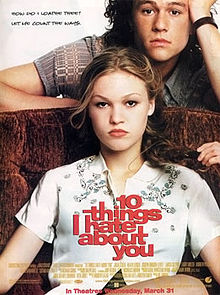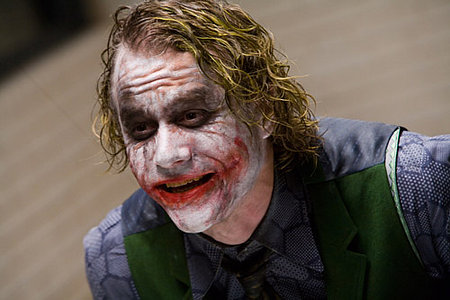Rachele on Shakespeare:
"A Modern take on Shakespeare through Media"





What happens on the Web stays on the Web!
Prompt 2: "How to make the perfect Peanut Butter & Jelly Sandwich"
Ingredients:
- Peanut Butter
- Jelly
- Slices of Bread

Step 1:
Using a knife, spread a generous layer of peanut butter on one slice of bread.

Step 2:
Clean a knife with a napkin or use another knife so that the peanut butter and jelly do not mix in their containers.

Step 3:
Spread the jelly or jam on the other slice of bread. use slightly less jelly than peanut butter.

Step 4:
Put the two pieces of bread together with the peanut butter anf jelly sides facing one another. Cut the sandwich in half for easier eating.
Helpful Tips & Suggestions
If you use "natural" peanut butter that needs to be refrigerated, let the peanut butter come to room temperature before you spread it to avoid tearing the bread.
Available on Web only
The use of a video truly enhances any "how to..." paper because it allows one to visualize both the order of events for easy comprehension and how the output should appear. On the web, one can view a video that explains via audio how to do something as well as follow along with the directions. For example, this video, "How to make make a perfect peanut butter and jelly sandwich," really captures the attention a viewer because he or she can hear and see how it is done.
At the same time, a web source, such as this offers a user the chance to pause, rewind, or play the video at his or her own convenience. If something is explained too fast, it is very simple to just replay what was said for complete and utter understanding.
Web videos also allow the opportunity for user comments. If something is not explained fully or could use additional information, any viewer can post beneath and receive a response from the creator of the video. The web is far more user friendly and allows for a vast amoount of information to be learned in a much quicker fasion.





The Hunger Games
Prompt 1: "May the odds be ever in your favor!"
The trilogy, The Hunger Games, by Suzanne Collins, is a series delving into the ideas of throwing innocent youth into a dangerous arena together to fight for their survival. For me, the simple idea of human puppets comes into play, where an outside force controls these practically helpless children into acting out in rather sadistic and dehumanizing manners.

Another common theme of The Hunger Games, is the idea of the loss of innocence. Although Katniss volunteered herself as tribute, taking the place of her younger sister, Prim was forced into an uncomfortable situation. If she had gone into the arena, she would have experienced bloodshed beyond comprehension, death of alliances, or even death of individuals she had to kill herself. However, since Katniss volunteered herself, Prim had to watch her sister struggle through those exact things and feel as if Katniss' life was in her hands. Safe in District 12, Prim felt helpless and could do nothing to save her sister even if she tried.
On another note, even though the concept is kind of morbid, I loved these books. They were very intriguing even though these theories have been touched upon before because this novel focuses on children. I once read a short story called, The Lottery, by Shirley Jackson, that also sacrificed humans to both remember starving in the past and hope for a good harvest in the future. At the time of its publication, reaction was extremely critical and people even cancelled prescriptions to The New Yorker, the newspaper where the story first appeared. Some countries even banned it; however, this notion of human sacrifice has been prolific in both peoples' past and present.
Just to leave off on a "punny" note, I read a funny blurb about The Hunger Games in the past couple of days since the movie release. "If I am excited for The Hunger games does that make me part of the Capitol?"





Thoughts on the Class
Prompt 4: "Tell me what you've Learned, what you've really really Learned"

This class has genuinely taught me how to generate a functional and aesthetically pleasing webpage. I can navigate my site and others with much more ease than in the past, which both saves me time and helps me attain more information. I understand how to utilize certain codes and shortcuts to beautify my webpage, which is actually really exciting for me because I generally have difficulty working on computers and with the Internet. I actually find stylizing my page entertaining and I enjoy working on and improving it.
This class will actively give me the ability to create a professional webpage that can help me in receiving a job in the future. I can include and upload my personal resume and more information about myself. The webpage itself is a skill that not all workers attain before applying for jobs, so I can use my knowledge to my advantage. In addition, if I ever own my own business, I can create a webpage for my company or shop that will be adequate.
Shakespeare in itself is a very complicated genre of popular culture that has become mainstreamed into Western society as classics. This Shakespearean experience has broadened my understanding through the vast amounts of symbols and allusions utilized. Classics teach a bit of history that cannot be learned in modern texts, in a time when life was different and even harder (i.e. the description of a female's body and the focus on male dominance). Before this class, I did not understand Shakespearean writings nor did I catch the subtle or even not so subtle nuances; however, now I can read a Shakespeare text and gather what is said with much less effort. References to Shakespeare can now be understood and discussions can be completed successfully.





Much Ado about Nothing
Prompt 1: "UnVEILING Comics"
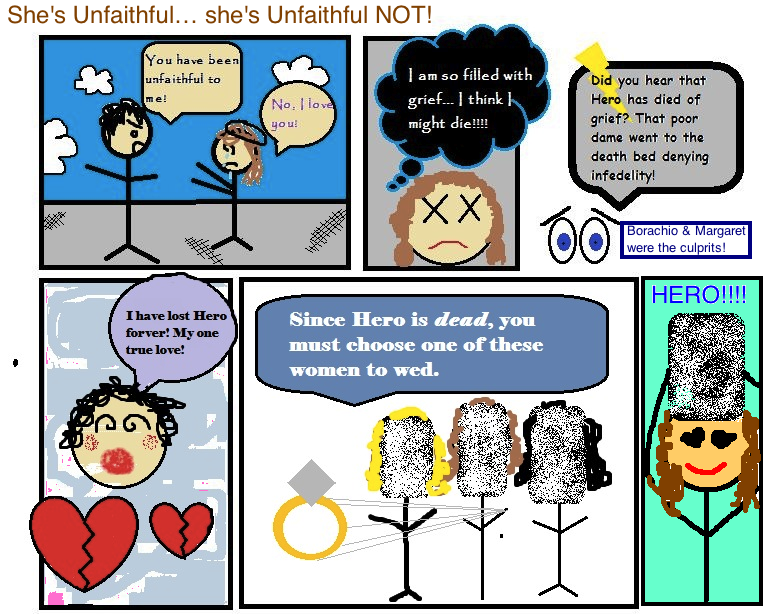
This webcomic, which was created on Paint, represents the scene where Claudio believed Hero cheated on him with Borachio. He called off the wedding, leaving poor Hero distraught and confused. When she faints, the Friar convinces her to pretend she died of grief because he believes she was framed. Her "death" could extract the truth from the tricksters and make Claudio feel guilty.
When Don Jaun's scheme was brought to light and Borachio and Margaret were identified as the culprits, Claudio was informed and greatly disturbed that he falsely accused her. He posted a nice epitaph for Hero and agreed to marry one of her cousins as a sustitute.
Upon removing the veil from the girl of his choice, Claudio discovered that she was truly his Hero, and that the whole situation had been planned to get them back together. It simply took some time for the perpetrators to get convicted and for Claudio to realize Don Jaun's horrible trick before she could reveal herself again. In the end, Hero and Claudio wed along with Benedick and Beatrice.





A Midsummer's Night Dream
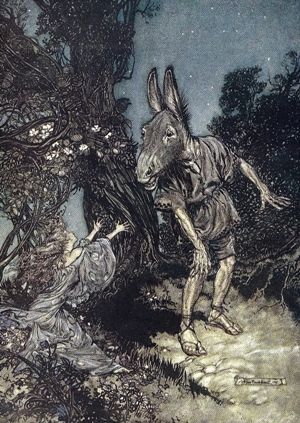
Prompt 3: "Image Imagination"
In Rackham's, "A Midsummer's Night Dream," the pictures cast a dark and gloomy ambiance, setting the reader into a melancholy tone right away. As a reader, I am intrigued by pictures because how much they offer in terms of comprehension. Although Rackham's pictures tend to be sporadic throughout the story, each picture is very detailed with hidden messages and meanings.
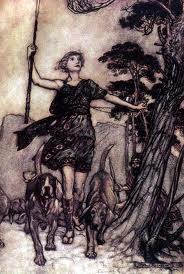
For example, on page 132, you see a queen marching triumphantly to a mountain's top. You can tell she is fierce with her spear at hand and loyal hounds at foot; however, behind her creeps a figure with a spear of his own. First reaction to this picture is one of conquest and achievement, but further scrutiny shows that this stalking man may be hunting her down, thus the hidden message. The image, although explaining some of the present written word, foreshadows something that may happen to the queen in the near future. Image definitely allows the reader to interpret more about upcoming events, while defining the exact tone we should emit.
The picture does encompass the entirety of the page, even though there is some white space boardering the illustration. This causes the reader to focus directly on the picture, visualizing the scene without having to read any direct text. With the caption reading, "We will, fair queen, up to the mountain's top And mark the musical confusion Of the hounds and echo in conjunction," the eye is first drawn to the queen as she marches up the hill with the hounds howling as her music, neglecting to notice the man in the background. The image is somewhat mesmerizing through her fierce clothing, proud walk, and spear weaponry and you can feel the emotion in the picture.
The image does utilize color, but in sepia and earth tones. This helps the story because it underscores the ominous and mysterious tone felt throughout the piece. The colors also aid in camouflaging the man behind the tree, which leaves the reader with the ability to foreshadow the possibly threatening future.





Taming of the Shrew
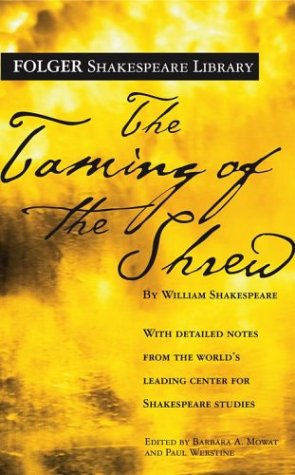
Prompt 1: "I Watch, I Listen, I Compare"
The actor, Heath Ledger, from the film, 10 Things I hate about you, embodies a typical "bad boy," with the smoking and a bad reputation, who is thrown into a relationship with the most hated girl in school. Of course in the end, against all odds, he becomes entranced by the "Shrew" and falls in love.
Although Heath Ledger usually does play that dangerous character with his long hair and clever smile, this role was drastically different than his other roles, such as The Dark Knight. Not only was Heath Ledger cast as a villian, but the style of his make-up and his greasy, long hair created an ominous appearance. The acting styles differed through the approach Ledger took. In 10 Things I Hate about You, he had to clean up his act for a girl; quit smoking, become more sensitive, and prove himself so he could win her love, whereas in The Dark Knight, he remained the antagonist. In reality these two films differ because in one Ledger is a dynamic character, as he becomes the perfect man, and in the other he is static, constantly destroying Gotham City.
The style of lighting the two films employed also altered the acting styles of Ledger because in 10 Things I Hate about You, the movie was very bright and optimistic, while in the latter, the lighting remained dark and sinister. These two films cast completely different attitudes by Ledger even though he uses his wits and sly actions in both to get across his point.
I chose these movies because they are completely opposing to one another, yet somehow Heath Ledger is able to keep his "I'm too cool for school" attitude in both. Personally, I was impressed at how well 10 Things I Hate about You resembled the novel, Taming of the Shrew, even though it was a very modern take.
